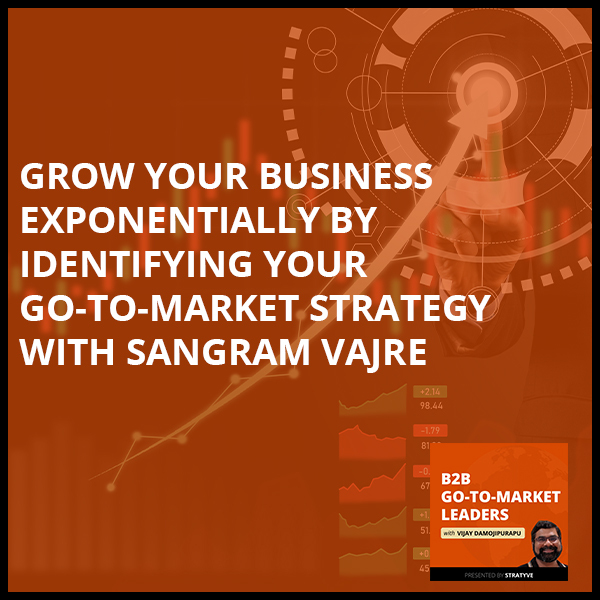
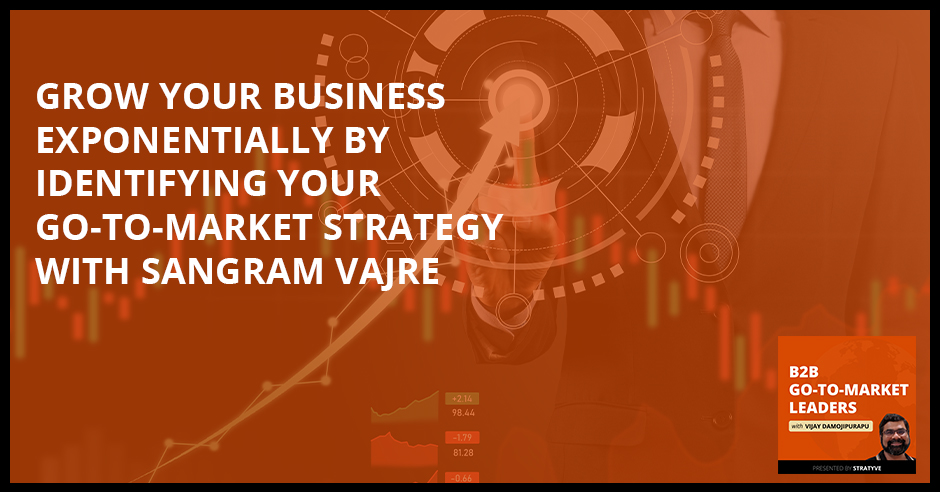
One of your main goals as an entrepreneur is to grow your business. While there are many ways you can go about that, Sangram Vajre, co-founder at Terminus, believes that the most important thing is for you to truly understand the go-to-market and what a good market is. He tells Vijay Damojipurapu that go-to-market is a process of transforming your business consistently and there are different stages that can help you with it. There’s the ideation stage, transition stage and the execution stage. All these stages combined with a great understanding of the platform market fit and product-market fit will create a path to your business’ success.
—
Listen to the podcast here
Grow Your Business Exponentially By Identifying Your Go-To-Market Strategy With Sangram Vajre
I have with me the one and only Sangram Vajre. Sangram, welcome to the show. I’m super excited to have you here.
Vijay, I am looking forward to this. We’re going for it. Let’s see what comes out of it.
This is the first time that I’m doing an ad hoc show and let’s go with the flow. I know it’ll be super valuable and insightful for the audience as well. Let’s start with the signature question that I always ask all my guests which is, how do you define go-to-market?
Creating market is something that most people don’t think about. Share on X
It’s an important question as I’m sure everybody’s talking about it. As you know, I’m writing a book on go-to-market, so this is very near and dear to me. I’m going to give you two. One is a simplistic one based on my interview with Brian Halligan, who is the CEO of HubSpot. I think he nailed it. One is more of a holistic one where you connect the dots when you pull everything together. One of the interviews that I did for the book was with Brian. They just crossed that public company with 100,000 customers. When I asked him about go-to-market, his response was, “It’s like a product.” That’s his view on it. It’s not something that you go on an offside and draw a bunch of different things, get your team together, kumbaya and then you’re done. No, it’s a product so it’s iterative. It is bug fixing all the time. It goes off the rails and then you have to pull it back in. You have to continue to change, edit and keep moving. He looks at go-to-market as a product. I felt like that nailed it in a sense.
Now, taking a more bookish definition of this thing, what I’m writing down is that go-to-market is a transformational process. It’s a process of transforming your business consistently. It’s a transformation process of accelerating your path to market. That path to market could be many different forms, but it’s a path to market with high-performing revenue teams. That’s where a lot of people mix it up.A lot of people think it’s marketing and sales, but it’s marketing, sales and customer success. What all of this does is creating a connected customer experience out there. Putting it all together,go-to-market is a transformational process for accelerating your path to market with high-performing revenue teams, delivering connected customer experiences.
I love both those definitions and views. I love what Brian mentioned there, which is having the perspective and lens of go-to-market as a product. It’s evolving. There’s a V1 version and a V2 version. It’s always evolving. There’ll be bugs that you need to fix. The only thing that I would add Sangram is absolutely for sales and marketing-led organizations is those companies and the teams, which is the marketing sales and customer success. When it comes to the product-led growth teams, you got the product. You also have the user experience and the design teams.
It’s definitely a big part of it and quite frankly, when I was researching if I should write another book, this will be my third book as part of this journey, I’m like, “I’m not writing into the ABM book. I’m done. I’ve written two of them.” What came about as part of the research was most people forget customer success. They completely missed out on that. You and I both know that retention in many ways is the best way to grow your company. If you can retain your customers and more importantly, if you can upsell and cross-sell or as we like to call it upserving our existing customers, you’re going to have an outsized impact and valuation on your business, but most businesses are not thinking about it that way.
It’s interesting but you bring in a great perspective. When I was researching, the only types of books I found on go-to-market were either channel-based like channel sales-oriented or product launch. The go-to-market product launch in a new region, go-to-market launch of a product in the same region or new product. Itbifurcated either into sales or product launches. It missed it. You’re right, the product is a big part of it and without that, it won’t work. There are other elements to it, which is the team or what team looks like, the RevOps, how the operations of the company look like. We can talk about that. Ultimately, the ownership like who owns it. I think that also becomes a mystery for a lot of people. I had so much fun researching and working on this thing.
We can go on this topic for hours together especially the RevOps who owns it, but we’ll save that for a later time in the show.Let’s switch gears a bit over here. Walk us through your journey. What brought you to this stage from maybe your grad days. Why did you go down this path? Enlighten us on that.
My master’s is in Computer Science.Most people think master’s is amazing and you have to do a lot more work. For me, it was party time. By the time, I got into master’s program, everybody would ask me to go and present the stuff they create. It was all project-based. I thought, “I’m a great presenter. That’s why they’re asking me to present my team.” They will always want me on the team so that I can go and present. Years later, they told me the truth which is, “You know what? You’re just a bad coder. We didn’t want you to code, so we pushed you on the stage.” It gave me a kick into the idea that I love communicating. I love the a-ha moment that people would get when you can take a problem and put it out there in a way that people can consume it and people can repeat it and relate to it. It made me think like, “That’s something interesting.”
Over the period of the first few years after graduation, I got a taste of marketing. I even had a couple of start-ups that failed miserably and those were moonlighting it. I love the fact that I can launch a website overnight. I can launch a product. I can see what happens. I can see from messaging if it’s going to work or not going to work and change it on the fly. I think that those dopamine shots of what marketing gives you was amazing. Iwent from being a program manager at a pretty good-size company to finding a marketing analyst role in a start-up because Iwanted to learn the art of marketing. I didn’t have a marketing background. Long story short, I feel like that has given me the edge because I’m not looking at it from a marketing perspective. I’m looking at it from a people perspective. I don’t even have a marketing way of looking at it. It’s like, “What would I like? What would people want to go? How would people want to engage? How do we bring things together?” That has helped me get to where I am now.
Back in the 2015, 2016 timeframe, you decided to co-found your own company. Why did you go down that path? A lot of people call the founders crazy folks like, “Are you out of your mind or what?” Why did you go down that path and how did that help you grow in terms of go-to-market?

I shared some of this sometime back in one video that we raised in the last round. We’re having our second baby, my daughter Kiara. I was at Salesforceso I was doing fine. My wife, Manmeet had quit her job and she was at home. We wanted to have that time with our kids and then I meet these two co-founders of Terminus. It’s classic. We meet at a bar and we’re like, “We need to do this thing.” I get super excited, come back home and tell my wife. I was like, “I want to do this thing called Terminus. It’s a brand-new thing. Nobody knows about it,” which is pretty much what everybody says in the start-up world, “It’s going to be big. It’s going to be massive.”
We just had our second baby. After a week of back and forth, my wife said to me, which was the most powerful thing in my life and something that most people don’t think about and overlook what you need in a partner. She looked at me and said, “Sangram, I know you want to do this and if you don’t do it, you’re going to regret it.” I’m like, “You’re absolutely right.” She did something that every partner should do. She said, “Fine. I’m going to go get a job,” and she got a job in a couple of weeks. We put our baby in a daycare, which we didn’t plan to at that time so early on like six weeks into the process. She said, “Here’s the thing.” This is the most powerful thing of all. She said, “You have one year. In one year, show me this thing has legs. Otherwise, you’ve got to find a real job.”
You can think about the silence at that moment. I got this opportunity for whatever but the timeline was incredible. From a go-to-market perspective, I feel like there was a clock on me and I wish everybody would think like they have a clock on them. I had one year to prove this. Otherwise, I’ll have to do something else. We did the Flip My Funnel movement. We launched and we did four events in the first year to build this ABM movement around that. We brought in even our competitors to speak at our events. We can talk about that.
It was our go-to-market strategy. It was to build an industry event, an industry conference, an industry movement so people would look at us. Otherwise, who would look at the first-time co-founders out of Atlanta? Nobody. We wanted to create a movement so that the industry will look at it and I only had one year to prove it. We hit $1 million in revenue in the first year. I remember walking in every day, looking at her. We have two kids. She’s doing a job and everything else that a mom does and I’m trying to do all this stuff. If she wouldn’t have put that timer on me, I don’t think we would have done some of the crazy things we did.
Kudos to your wife. It’s wonderful to have such a great partner and I’m sure you are exuding gratitude every day. I can sense that between the two of you there.
Honestly, as you raised, I shared this openly. I took some chips off the table and I went back and said, “Here’s the money. You don’t have to now go get a job or do the job,” because she’s been doing that for the last six years. It’s a choice that you have if you want to work or not. In a way, it opened up doors for her and she could just get back to the way she wanted to go. It’s a long journeylike six years. I didn’t think either one of us thought it will take me six years to go or do anything, but I think we’re finally back in a position where she has a choice as opposed toshe has to do it.
You mentioned about in year one, you brought in $1 million in revenue. I’m assuming you were bootstrapping or maybe some amount of Angel investment back then.
We hit it early, about $300,000 from David Cummingswho was the CEO of Pardot to kickstart. In the first year, we hit $1 million, the second we hit $5 million, and the third we hit $15 million. That was our first three years of trajectory.
It goes back to your core principle and core value as well, which you executed in year one which is without a community, you’re a commodity.
I learned that. I was at Salesforce so I saw what Marc Benioff did with Dreamforce. When you think about HubSpot, the reason we know Brian and he had invested in Terminus is because he looked at this and said, “You remind us of us because HubSpot started inbound.” That’s why I feel like in many ways, Terminus is doing like if you talk about category leadership or category creation, you’re not trying to create a market fit company. You’re creating the market. It’s a different idea. At some point, you need to go back to the product fit and we can talk about the three stages of the business. Ultimately, we were in a position where we have to create the market because the market did not know, care about and did not see ABM. There was no analyst talking about it. There was nothing.
There is a bigger vacuum. Talking about crossing the chasm, there was just chasm. There was nothing. There was no crossing going on. It was a whole chasm that we had to put a bridge on for people to move from one side of lead-based funnels that has been from the beginning of time of sales and marketing to flipping the funnel and saying, “No, you don’t have to do that.” It was creating the market. I feel very fortunate to be part of that.
As part of what I do at my company, the go-to-market consulting company named Stratyve, I get to work with founders and interact with founders. One piece of advice that I give them is how they can get and find and earn their first set of early buyers. When you’re going from zero to one, that’s the fundamental challenge. When I advise them around doing outbound initially, but with the end goal to drive inbound. It’s not just outbound cold calling and that’s about it, but you actually are building affinity towards your product, company and brand. One thing that they struggled with is and they adopt the principles of is, “Let’s just go and sign up the first beta customers, the first pilot customers,” Whereas you do the other approach, which is to build a community, a following, and then they’ll come to you for your product.
If you think about it, going back to the timer, I had one year. One year is too short of a time to create a product and product-market fit and all this stuff. Even the Flip My Funnel was by accident. I don’t want to take full credit for it saying that it was so brilliant that we came up with that. It was an accident. When we launched Terminus, we said, “We need to do an event and let people know.” I reached out to all the people I knew who could sponsor it and nobody wanted to sponsor it. I asked them why. They said, “We don’t know Terminus. We don’t want to back your product. We don’t even know what you guys do.” I’m like, “That’s crazy.” I’m like, “Fine.”
For marketers who are in the ideation stage, don’t try to look at segment and cohorts. It won’t make sense to you. Share on X
This idea of Flip My Funnel came about on a flight from San Francisco to Atlanta, where I was stuck in the middle seat between two drunk people. I was flipping on a piece of paper, the funnel. I’m like, “What if it was Flip My Funnel?” By the time I landed, the Flip My Funnel thing was born. It was just a crazy flight but I reached out to the same people. I hope people lean into this one. When I reached out to the same people again after a month saying, “We scrapped that idea. I just bought a domain for $8 called Flip My Funnel and I want you to sponsor the Flip My Funnel Conference, which is all about challenging the status quo of marketing and sales. There’s no need for you to do anything other than talk about how marketing and sales can challenge the status quo.”
Idid videos for people like Meagen Eisenberg and all these people who are influencers of that time saying, “I would love for you to come and speak at this event. I’m not asking you anything other than you speak. You get the keynote.” We are reaching out to our competitors and said, “You can come in and do a keynote.” We will be in a booth like everybody else. What’s interesting is 300 people showed up at the first event. What I learned in that very thing is that people don’t want to be behind a product. They want to be behind a movement, a problem that they want to be solved.
You go back and hindsight is 20/20. Salesforce could have created Salesforce but they created Dreamforce. HubSpot has created HubSpot, but they call it inbound. Gainsight created Pulse. Growth created hypergrowth.Terminus created Flip My Funnel. Now you can start seeing the groundwork of that’s the way to build newer birth almost in that new category. That wasn’t something we did. We did that out of because we didn’t have funding and nobody wanted to sponsor our event. It came out of complete necessity.
Creating a market is something that most people don’t think about. That is part of the early stage go-to-market. You can be either a product feature company immediately and if the problem is there, it makes sense. If you want to build a billion-dollar business, you have to go beyond the product in the early days. We could have called ourselves account-based advertising because that’s all we did in the beginning, but we didn’t call that because it would have been limiting for us to call over sales and advertising, and then we’ll have to rebrand ourselves and re–imagine. We wanted to call it bigger. That’s the vision of trying to build a category. It’s a journey between in many ways, what I look at and what I’ve written in the book around problem-market fit to product-market fit to platform-market fit. We can dive into it if you want.
We are still working on our product but guess what? Salesforce is still working on its product. It’s a never-ending thing. There’s always one more feature that will change the world, but it never does. You’re absolutely right. We obsess too much about the product. People don’t want to get behind the product. They want to get behind the problem so it’s a bigger story.
Let’s dive into your new upcoming book. You mentioned the three phases. I think you walked us through maybe phase 1. Walk us through the phase 2 and 3 that you talked about in the book and how you see Terminus where it is now versus in the next couple of years.

The book has a framework that I’ll get into in a minute, but at the highest level, at the stage level, it talks about the three stages, which is ideation, transition and execution. Let’s imagine those as the three stages. An ideation stage is the problem–market fit. Is there a real problem? Is the market big enough? That’s a classic challenge that every early-stage founderwould face and have to figure out and test everything they can. At some point, they go in and they find like, “We are able to sell this thing.” They go into this product market phase, which we all know in SaaStr and Jason Lemkin, all of them have evangelized that, which is you are able to sell it and you’re able to sell more of it. Now, you know what the market is. When you can sell it, you can increase the price of your product and you can go into multiple different segments.
At some point, even that stops or plateaus, if not dips because there’s only so much you can do and at that time, the market is vacant so more competitors are going to come in the market. Now if you are a product company, then you will have to start doing pricing war and territory war, and all these things that don’t help. All of a sudden, you’re growing and you plateau or go down. The reason might be that this is the time that you need to go to the execution stage which I call the platform–market fit. This is why every company at some point have more than one product. At the same time, even their market changes to go to more than one persona.
Let’s take our classic example like Salesforce. Salesforce stage was a sales CRM for ten years before they started to become a platform company by adding marketing and success and all the dev stuff that they have put in Chatter. All those things came up later and they turned them into platform–market fit that allowed the existing customers to upsell, cross-sell and upserve. That’s why the retention is so much higher and the value of each customer is so much higher. It’s the journey of companies from problem– market fit to product-market fit to platform–market fit, and then the framework that we can go in a second, but I wanted to see your reaction to that. Those are the three business stages that have been outlined in the book.
I see that as problem–market fit, product-market fit, and then the platform–market fit. I’ve seen variations as well. I also want to get your thoughts around where you see the product–channel fit within these three stages.
Without the product or without a good product, all of this would fail. At some point, you need to have a good product. People say that Salesforce has the best CRM in the entire world. Can nobody build a better CRM? Of course not. There are better CRM than Salesforce, but they created an ecosystem around it in such a stronger way that it’s hard for anybody to penetrate that and own it. They know it. I was at Salesforce. They are like, “We need to change this,” but they haven’t changed much of it and/or trying to because they’re adding different things and that still doesn’t become the main line of business. The product is at the core of it. It’s got to work but I would submit to you that it doesn’t have to be the best.
That is the part that is hard for people to listen to and almost feel like, “We’re popping out.” I’m like, “No, it doesn’t have to be the best.” Just like Excel spreadsheet, most people don’t use all the features of Excel spreadsheets. Somebody created these 90,000 features in it. It could be done with 25 features that we all need for the most part, but it still has 90,000 features. You don’t need that. You need the main thing. The product is very important but over-rotating on the product and feature is where people start saying the heavy investment in R&D and at the same time, you’re not paying enough attention to the market. You get competitors who can do what you do and maybe sleeker, faster or cheaper and then you get into another issue. Now the cost of your dev team becomes the issue. That should never happen. You should never be overspending on that unless you’re never going to have marketing and sales.
I think especially founders coming from a very product-intensive background. They over-rotate and over–invest in product features, especially when it comes to marketing and sales. You can invest in those in R&D, but when you go out and speak with your prospects, market and customers, and even partners, focus on those hero features. That’s what I call them. The hero features like 1 or 2 where your product kicks ass and does exceedingly well compared to alternatives.
I’m curious about your view on this because you’re working with so many different companies. It’s okay to realize that you’re not trying a new category. You’re trying to be in an existing category. Not everybody has to go and try to build a new category. As a matter of fact, everyone says, “We want to do what you did.” I said, “Don’t do it. It’s hard and painful. You don’t know if you’re going to make it.” We could have created a red carpet for ten other companies. We don’t know but it’s hard. We have to build a movement and a product on top of that, build the team. It just exponentially gets harder. Starting a company is not hard, so don’t do it. Not every company has to do it, but if you’re going to do it, you have to do it very authentically. You have to have a long-term view of it. It cannot be another marketing campaign.
You hit that point very well, Sangram, which I want to emphasize and I’d say that to the folks I speak with as well, which is we all wish and dream that we are creating a category and doing the entire blue ocean strategy. That’s the Holy Grail. You don’t go with that on day one, only with that selfish intent versus go out in the mindset of, who are my buyers and how do I serve them in the best possible manner? In the process, if the category happens, you earned it. All of the forces aligned for it to happen. You cannot go out and create a category on day one.
I would have a different point of view on that. Either you go for it where you have that long leg. Can you imagine Marc Benioff not doing what he did in the early days? He wanted to go and create a new category. You think about Brian and Dharmesh, they wanted to go and do something. I remember this conversation. I asked Brian and Dharmesh with HubSpot when we’re talking about investments and all that. They’re like, “We are going to invest in it for the next ten years and we’re going to continue to invest in it.”
The valuation of your business and the ease of your business changes as your gross retention rate starts to get better. Share on X
You look at the consistent pattern. It’s all the founders. Marc Benioff is the founder, I’m a founder, Brian and Dharmesh are founders, David Cancel for Drift is a founder, Nick Mehta is a founder. It is not a marketing campaign. It’s not a sales campaign. It’s not a tactical thing. It is the DNA of your company where you have to champion it. In many ways, you have the opportunity to lead when you decide to go do that, but when you are on it, if you don’t do it authentically, people are going to see through it and it’s going to be more harmful than not.
The way you can do it authentically and how you map that issincerely understanding your buyer. That’s where and what it boils down to. How do you go out and sincerely understand? You may have those bunch of meetings. You may not get that a-ha insight right away but stay curious. That’s what I always tell folks. If you look at Terminus now versus a couple of years downstream, where would you map Terminus to in the go-to-market phases?
We are right in the middle of product-market fit and platform–market fit if you are in that phase because we acquired four different companies. We have multiple different products and we are creating. We definitely are from a product to platform, but we haven’t nailed the full market yet. We are 1,000 customers. We aregoing in the right direction, but we’re not there yet. It starts all over again. It’s an ongoing thing. The four questions that the book and regardless of what stage we are, you have to answer. I call it the MOVE framework, which is Market, Operations, Velocityand Expansion. That’s how you know where you are. Anybody who’s listening to it, you just have to keep asking the same question, but the answer is going to be different based on the stage of the business.
For example, in the ideation stage for the question of like, “Who should you market?” I don’t know. This one, I’m going to look at every heartbeat in this region. I know it’s customer success. I know it’s the market. You’re going to keep going at it and you’re going to figure out and market. In a product-market fit section in the second stage, you’re still asking the same question, but now you know where the product works and what your market looks like. The answer becomes how are we going to create segments? In the third one, think about the execution, the platform–market fit, the same question, who should we market? Now you’re looking at customer cohorts and seeing which customer cohorts we can jump in. You can see the same question but in a different focus.
It’s the same thing for operations. The question is the same as, “What do you want or what do you need to operate effectively?” Not efficiently but effectively. In the early days in the ideation stage, you might have an ad hoc system to report and operate your business. It makes sense in your spreadsheet later on in the transition. Now you’re going to be aligned. You’re going to do account-based maybe and you get marketing and sales at a minimum aligned on it. If you go to the execution stage, for the most part, you’re probably going to have a RevOps team. Almost every organization is going to start having a RevOps team that no longer you’re going to walk into a meeting saying marketing has a different number and sales has a different number. You don’t need to do that. You can look at the maturity of your organization and jump into that.
The third one is a velocity question, the when question. When can we scale our business? I’m sure you get that question a lot. When can we scale that business? When we get to the problem–market fit, that’s maybe because everything is reactive for you. At this point, you’re reacting to whatever comes through. The velocity hasn’t jumped in. In a product-market fit, now you’re becoming proactive. Everything is working and you’re trying to be proactive and get ahead of the sales quotas and making sure things are happening. In the execution stage, now you’re prioritizing. Now you’re pulling things together. You’re not looking for the next fire. You’re being opportunistic about it.
The last one is the expansion phase, which is the where question. Where can we grow? That’s the fourth question. The market is who, the operation is what, the velocity is when, and the expansion is where. Where can we grow the most? The answer lies in the same, in the ideation stage. Maybe it’s in the outbound sales team like you‘re talking about earlier, but in the transition stage, you may actually have a channel sales partnership like HubSpot. They have a 40% revenue coming from the agency, which is a completely new way of expanding without having all the people. As you grow, in the execution stage, it might be even further than that, different locations, EMEA, geographies, verticals, all that stuff. Using these four questions is almost the navigation for you across the three stages of the business. This is where a lot of my pieces lies off.
That aligns very well with a conversation that I’m having with a founder of a CSD company. They found success in the enterprise market. Now, the founder and I were speaking and he wanted me to come up with a down-market scenario. A lot of people do the SMBs and then go upmarket. In this case, he wants to go down-market and go tackle the SMBs and the mid-market. During that phase, the founder was approaching with the mindset of, “I’ll have the SDR doing the cold calling and just building up all the pipeline, and a product marketer for all the demos. Eventually and hopefully, we close some sales.” I go, “That’s not going to cut it. You can but a couple of years downstream, you’re going to get tired. It’s going to be exhausting.You’re essentially applying a scaled-down version of your enterprise, go-to-market motion to SMB, which may not fly. You want the efficiency.”
I also emphasize the path of you need to go back to basics. SMBs and mid-market is an entirely different category. They don’t know you. Find those early buyers. Going back to your three phases. That’s what I was telling this founder, you need to go back to basics and then once you attain that product-market fit, that’s when you apply scaling. Coming back to your MOVE, it’s the velocity and the execution phase.

It’s a game-changer. I love the pushback and I’m glad you brought that up. It’s important to recognize that companies can go upmarket, which is a normal thing that we would see, but also going down-market, which is like freemiums and products that they want to offer because they want to figure out the scale in it. That’s a completely different sales motion. That’s a completely different go-to-market motion. You can’t mix them because the cost of acquisition goes rapidly high on it. It’s a sales motion. Where you can grow, trying to answer the expansion questions, it’s very possible that companies would try a new boat with the same team, which sounded like what this team is planning to do. It might completely backfire because it’s not going to make sense from the ratio of that new to actual customers.The pricing won’t make any sense to have a full-time SGR working on all of those. You have to completely change your go-to-market motions.
That’s what I’m emphasizing on. You need to change your go-to-market motion in terms of it’s going to be a freemium or a free trial. You need to also focus on what I call a hero feature. What is that 1 or 2 features that will blow the mind of your buyers, such that it will increase that option and not just that, it’ll increase the virality effect. They are going to be your word-of-mouth referral machine if they love your product. That’s what I was pushing back on and emphasizing with this founder.
It’s not easy. I think going down-market is way harder than going up-market for sure.
Let’s go into some of the things that I want to touch base with you, which is when it comes to 2021 and even 2022, what do you see are the major goals and challenges for Terminus?
I think we are hitting a point because we’re right in the middle of the transition and execution, which is product market and platform market, we’re seeing what we should expect to see and going quickly back to that. The biggest challenge I see is people don’t know where they are. When they don’t know where they are, they’re measuring the wrong metrics and trying to emulate somebody else who they are not there yet. I hope that is important for the audience to know. If you’re in the ideation already stage, don’t try to look at segments and cohorts. It won’t make any sense to you. The metrics that you measure and talk about are very different.
For us, we are moving forward from, how do we get the biggest $100,000-plus deals? How many more deals can we do just like that? How do we become in the magic quadrant? Not the Forrester Wave but also in Gartner Magic because that opens up the enterprise deals for us. How do we get there and stay there? How does our vision align with the analyst? After six years, analysts are finally saying ABM was a real thing. I’m like, “Great. Thank you. Put that magic quadrant again. We were looking forward to that.” If you’re going to enterprise and that is the goal, we want some of these things to happen. We’re looking at our gross retention rates and stuff because as I said, the valuation of your business and the ease of your business changes as your gross retention rate starts to get better. Something that in the early days’ ideation stage, we don’t even care about it. We don’t even think about it. The churn was so crazy in the early days. Now our return, you don’t have as much churn anymore.
These are the areas that we are now trying to fine-tune because now our business is all about we can grow this much organically. We can acquire a company and then we can add to it. That’s how we can have immediately another $10 million to $20 million in revenue, and then connect those two and try to see where other markets can we open up. Part of platform–market fit is having more products so your platform is growing, but also your market is growing. This is the part where many companiesfeel like they’re still going after the same market. We used to sell to CMOs. Now we’re also selling to CROs and CEOs. Our market has grown in that sense, different verticals, different regions have grown. It requires a different level of a set of people that can do those things as opposed to what we had before.
Something that struck my mind when you were talking about your market is growing, which is the entire notion of the total addressable market. It’s very misunderstood in the start-up community and even beyond. People think of the total addressable market as the whole world. That’s the extreme scenario versus in your case when you talk about the buyers, you’re targeting included the CMOs initially, and now you’re talking about the CROs and the COOs potentially. The initial definition of your TRM would be who are those CMOs that I can capture. It’s your niche. Focus on that one buyer and the user. That’s super important and then you can expand your TRM.
Identify whatever gift you have and double down on it. Share on XWe call it something. I’m glad you touched on this because we now call TRM the total relevant market. It’s still a total market as you start to think about it, but you can go after the entire market at the same time with that precision and targeted marketing or anything like that. What’s your total relevant market? That should go from everybody in the SaaS industry in North America to everybody in the technology sector within North America that has $50 million or more in revenue and with 500 employees. You started going into squishing your total market down to the relevant market. This is where we shine. This is where our use case delivers. That’s where I think it will work at some point very quickly. As you hit $5 million, $10 million or $15 million in revenue, it breaks. You start over again. That’s what I’ve learned in the last years is that every $5 million or $15 million, everything breaks and you start over. It’s interesting.
I was listening to a podcast during my run. It was the founder and the CEO of WhiteHat Jr who started the startup. They have experienced super crazy growth. They went from 0 to 1 crorebecause their market is in India. We’re talking about the currency which is 1 crore to 100 crores in 12 to 18 months. I might be butchering the metrics and the growth rate, but it comes back to how he visualizes the various stages. It maps to your journey or what you’re talking about, which is the stage from when you grow from 0 to 100 employees or 10 employees initially. You go from 10 to 100 and 100 to 1,000 and beyond. Those are three different stages. It also maps to your three phases somewhat.
That’s why I wanted to write this book because it’s almost opposite to who I am in many ways. I wanted to be super inspiring. I want to go and speak at events and get people excited about it. The book is almost a definitive guide to how to go off and go-to-market based on all these interviews. This book is a how-to book. If you’re looking for a vision book, this is not it. If you’re looking for how to connect the dots with your vision and mission or how to put your team, this is not it. This is about regardless of what size of business and what stage you are, this will help you find where you are and more importantly help you get your next move. What your next move should be, which relates to the MOVE framework. It’s helping you to figure out the next move.
We’re coming more towards a closing section over here and somewhat of fun but different topic from GTM. Talk to us about this whole PEAK Community movement that you started. What is the genesis, the driving factor, and what you’re doing with that and who should be part of the PEAK Community?
I’m an extrovert. I like to be out there and be in the community, andCOVID didn’t help with that. Where do I go nerd out? I couldn’t find a spot where marketers get to nerd out and talk about marketing stuff,a lot of things at marketing and sales. I’m like, “Great. That’s awesome but I want to nerd out as a marketer on top of branding. Talk about positioning, talk about ABM stuff, talk about all these things and I couldn’t find one.” In mid-2020, I started PEAK Community with a buddy of mine who also was like, “I’m helping a lot of people get jobs, but they don’t know what it takes to be a CMO.” We started this community called PEAK Community, which is for emerging CMOs and CMOs only.
This is not for anybody who’s just sitting around. If you want to do your thing, great. If you want to become a CMO one day or if you are a CMO, that’s what this group is about. We created a course for emerging CMOs. We bring in CEOs and CMOs to the emerging CMO group so they can get to ask them questions like,“How do you talk about equity? How do you talk about compensation? I’m a graphic designer. I want to be a CMO. What do I need to do?” I will bring in a CFO and be like, “Have you ever talked to the CFO?” It’s so funny that most marketers have no idea how and what will it take to become a CMO. They would get stuck and frustrated because of their silo specialization. The whole PEAK Community is really for marketers who either want to be on a path of emerging CMOs or are CMOs and just get better.
I think you’ve got a great community growing in PEAK. I joined out of curiosity and there are so many learnings. One thing that I took away and that I keep sharing with so many of the folks is as a marketer, it’s very easy for you to get so bogged down into the marketing and sales and product, maybe customer success. You need to go about that and start interacting and building the relationship with the CFO and HR.
Nobody talks about that. That’s the funniest thing. I asked marketers, “When was the last time you talked to your CFO?” “I don’t know. Why do I talk to them?” That’s a problem.
They’re giving you the budget.
If you don’t know your CFO, you’re not getting budgets. Thanks for being in the community. It’s fun. It’s all run by marketers. I do one event a month in that, but every week there is somebody else running the marketing events, non-sales. This allows marketers to get a microphone and not feel like they’re judged. Every other Friday, expert or something where somebody’s like, “I run ops, graphics, design, product marketing and here’s how I put my dashboard together.” It’s a lot of fun learning.
The final question for you, Sangram, is if you were to turn back time and go back to day one of your go-to-market career, what advice would you give your younger self?What is your first real go-to-market job?
I’m still looking for it by the way. The idea will be to not look for a job or not think about it as a job. If you find yourself like this is a job, you’ve already lost. What keeps me going or have kept me going has been the fact that I absolutely love what I do. As I said, we raised money. I could stop working now and be okay. That would totally make me go crazy because I love what I do. I love demystifying, making the complex simple, the ability to connect with people like what we’re doing right now, to come up with frameworks I love. I created the Flip My Funnel framework, the team framework in the last book, now the MOVE framework. I feel like that’s a gift that I have. I look at complex things and I try to make them simple.
Identify whatever gift you have and double down, triple down on it. There are a hundred million negative things with me. If you ask my wife, she will note every one of them very clearly, but this is a gift and it took me a long time to figure out. If I were to go back, I would have looked at and asked people around me much earlier to say, “What is the gift that I have that you see in me? Pinpoint me.” Maybe you can send an email to them. Maybe you can pick up the phone and call them. People around you know your gift already. It takes you a long time to dust off and figure that part out. If you know your gift and if you don’t, ask somebody near you and they will be able to tell you what your gift is. Just go for it. It took me a while to figure that out.

I made that mistake too. First is getting past the barrier of asking for help. That’s hard. The next thing is you may know your strengths, but get that validated. Ask, go out and reach out to your peers, ex-bosses, ex-managers, CEOs that you worked with and your friends as well. Ask what did they see your number one or top 2 or 3 gifts are. That’s a very key point.
You mentioned something that I want to create a distinction for people. The strength and gift in my view could be the same but could also be different. A strength is something that when you put time and effort in there, you’re good at it. In most people, they can put enough effort and they get good at it. A gift is something so natural to you that it’s effortless. Some people will look at me like, “How do you run a daily podcast, how are you running a company, and how you’re creating a community?” I’m not trying to say that I can do all things, but it’s effortless for me because that’s my gift.
If you ask me to change the toilet cover, I’ll be looking at it for five minutes not knowing where to start. If you asked me to go and do coding again, I would be flabbergasted. Can I figure it out and learn? Yeah, I could turn that. A gift is something so effortless. It’s God’s gift. It’s so effortless for you and everybody around you thinks,“I have no idea how Vijay does that.” To you, it’s like, “That’s nothing.” That’s the gift. It took me a while to know that that’s the gift. You can come up and do something so effortlessly that everybody will be like, “How does he do that?”
I’ll add one more. I appreciate you clarifying that. That’s a great point, Sangram. It’s important to call out and know the difference between gift versus strength. As you were saying that, it struck me because one of my key strengths is I’m a learner. I love to learn.When I look back and when people say, “You’re good at doing a podcast,” which you might call a gift in your terms. If I connect the dots, it’s that learning ability that I soak in and I seek more and more, that’s translating to that gift of hosting and doing it.
I love that you connected those dots. You’re absolutely right. The end product could be different but the underlying is the learning that you get. You can learn anything.
Thank you so much, Sangram, for taking the time and where can people learn more about you and any final message that you want to share with our readers?
Connect with me and Vijay and let us know what is the one thing you took away from this. That will make our day because this is a time commitment and hopefully, you’re pouring into it. I appreciate it, Vijay, that you’re bringing me on, but it only is valuable if somebody takes something and say, “I’m going to take that one idea and go do something about it.” Share with us and connect with us on LinkedIn. Let us know what is the one thing you took away from this episode.
Thank you once again, Sangram, and good luck with your upcoming book launch.
Thanks.
Important links
- Sangram Vajre
- Terminus
- PEAK Community
- LinkedIn – Sangram Vajre
About Sangram Vajre
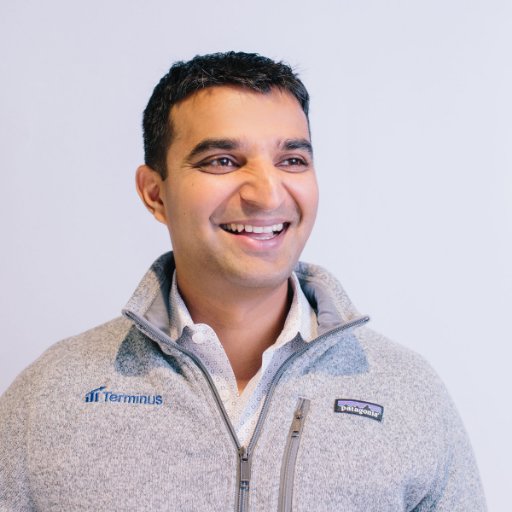 Sangram Vajre led marketing at Pardot (acquired by ExactTarget and then Salesforce for $2.7B). Soon after, he co-founded Terminus which hit $1M in the first year. Within 6 years, Terminus hit $120M, growing to over 200 employees and ranking No. 21 on Deloitte’s Technology Fast 500 list and best places to work. Sangram now serves as Terminus’ official “Chief Evangelist.”
Sangram Vajre led marketing at Pardot (acquired by ExactTarget and then Salesforce for $2.7B). Soon after, he co-founded Terminus which hit $1M in the first year. Within 6 years, Terminus hit $120M, growing to over 200 employees and ranking No. 21 on Deloitte’s Technology Fast 500 list and best places to work. Sangram now serves as Terminus’ official “Chief Evangelist.”
Author of two books on Marketing, including ABM is B2B: Why B2B Marketing and Sales is Broken and How to Fix it and Account-Based Marketing for Dummies.
Sangram is the host of the top 50 business podcast called FlipMyFunnel with over 100K subscribers and was named as one of the top 21 B2B Influencers in the world by DMN network. Sangram has spoken globally both live and virtually for platforms such as Leadercast, Linkedin, INBOUND, Entrepreneur and INC.
Love the show? Subscribe, rate, review, and share! http://stratyve.com/

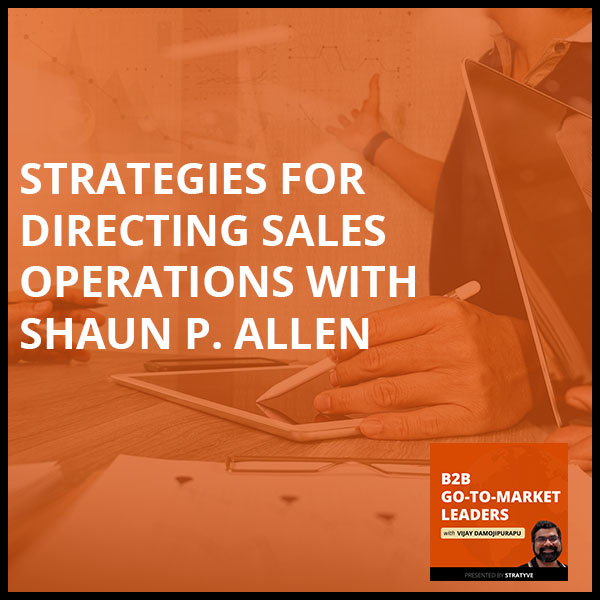
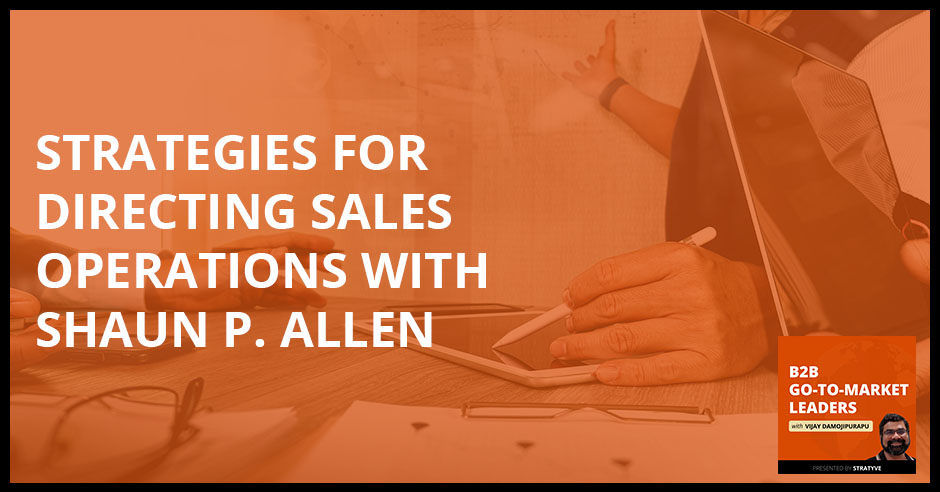



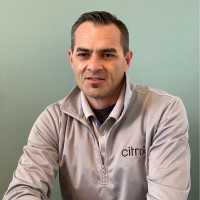 A growth-minded builder, in a few words. More specifically, leading large growth-minded Sales Organizations to win. Well-versed in building robust Digital Sales efforts, currently in SaaS Software sales for an industry leader (hint: workspace for everyone). Lucky enough to have worked with 50,000 + businesses and partners in their Digital Transformation journey. Just getting started though!
A growth-minded builder, in a few words. More specifically, leading large growth-minded Sales Organizations to win. Well-versed in building robust Digital Sales efforts, currently in SaaS Software sales for an industry leader (hint: workspace for everyone). Lucky enough to have worked with 50,000 + businesses and partners in their Digital Transformation journey. Just getting started though!